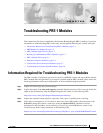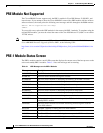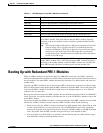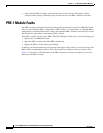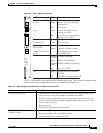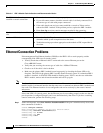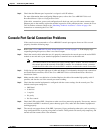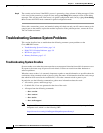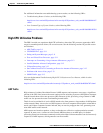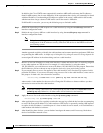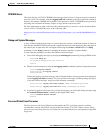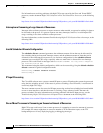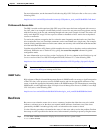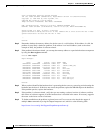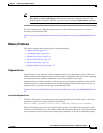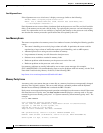
3-9
Cisco uBR10012 Universal Broadband Router Troubleshooting Guide
OL-1237-01
Chapter 3 Troubleshooting PRE-1 Modules
Troubleshooting Common System Problems
For additional information on troubleshooting system crashes, see the following URLs:
• Troubleshooting Router Crashes, at the following URL:
http://www.cisco.com/en/US/products/sw/iosswrel/ps1835/products_tech_note09186a00800b4447
.shtml
• Less Common Types of System Crashes, at the following URL:
http://www.cisco.com/en/US/products/sw/iosswrel/ps1831/products_tech_note09186a008010876d
.shtml
High CPU Utilization Problems
The PRE-1 module can experience high CPU utilization, where the CPU processor approaches 100%
usage for extended periods of time, for several reasons. See the following sections for possible causes
and solutions.
• ARP Traffic, page 3-9
• CPUHOG Errors, page 3-11
• Debug and System Messages, page 3-11
• Exec and Virtual Exec Processes, page 3-11
• Interrupts are Consuming a Large Amount of Resources, page 3-12
• Invalid Scheduler Allocate Configuration, page 3-12
• IP Input Processing, page 3-12
• One or More Processes is Consuming an Excessive Amount of Resources, page 3-12
• Problems with Access Lists, page 3-13
• SNMP Traffic, page 3-13
Also see the document Troubleshooting High CPU Utilization on Cisco Routers, which is at the
following URL:
http://www.cisco.com/en/US/products/hw/routers/ps133/products_tech_note09186a00800a70f2.shtml
ARP Traffic
High volumes of Address Resolution Protocol (ARP) requests and responses can occupy a significant
portion of the CPU time, because the router cannot use fast-switching to process ARP packets, but must
instead forward them to the route processor (RP). Because of this, processing a large volume of ARP
traffic can also prevent the router from handling normal traffic.
Theft-of-service and denial-of-service (DNS) attacks also often generate a large number of ARP packets
on the network. Many viruses also use ARP requests to discover computers that might be vulnerable to
attack, and if these computers become infected, they are used to propagate the virus, generating even
more ARP traffic on the network.
ARP requests are broadcast packets, so they are broadcast to all devices on that particular network
segment. In some cases, a router can also forward ARP broadcasts to an ARP proxy for further
processing. Some low-end routers commonly used by subscribers for home networks can also incorrectly
respond to all ARP requests, which generates even more traffic.



